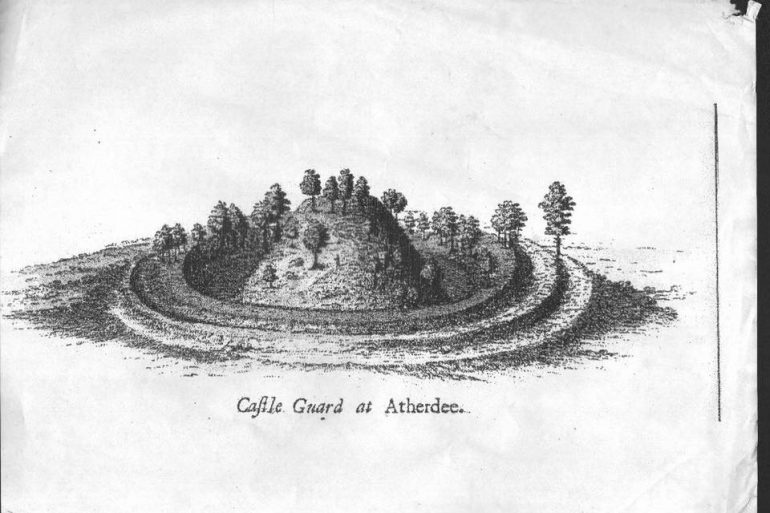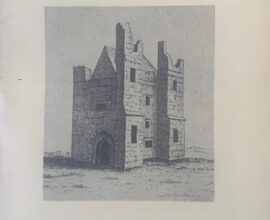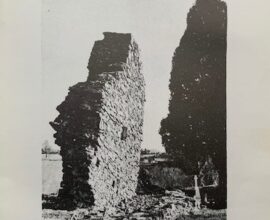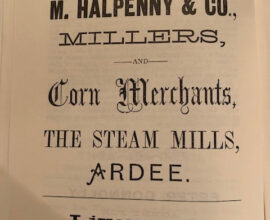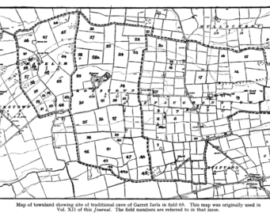Norman-French to Royal-English Ardee (Part 1)
The coming of the Pippards opens a new chapter in the history of Ardee because it was them who, as Lords of Ardee, developed the area from the sparse pre-Norman settlement it had been into a vibrant town. They also fortified the existing Celtic mound known as Rath Guaitherd (The stone fort of the high voice) but which, because of the Norman stonework built on it, later became known as Castle Guard and is now known locally as the Priests Mount because a parish priest from the town built a summer house on its summit.
Gilbert Pippard 1185-1188
Gilbert Pippard was the original recipient of the barony of Ardee from Prince John on or just before 1185. Up to that point the area which became the Barony of Ardee was held by a Celtic tribe known as the Fir Rois. He immediately made Ardee the Caput (capital) of his barony and set about fortifying it to use as a base to extend his control over all of the lands he had been granted. Little did Gilbert know then, when his men were fortifying the Celtic mound to the east of the town, that Ardee would, for the next five centuries, be a key position in the strategy of medieval warfare in Ireland against the Gaelic tribes to the North.
Gilbert resided at Ardee for only three years and, in 1188, he returned to England and was replaced at Ardee by his brother Peter. His reasons for leaving Ardee had a lot to do with his adventurous spirit as he wished to take the cross and go on the Crusades in the company of no less a person than King Richard Coeurde Lion (‘the Lionheart’). In the Winter of 1188 Jerusalem fell to the ‘Infidels’ and the Pope called on all Christendom for a Crusade to recover this most holy of places. By all accounts Gilbert distinguished himself in many major battles and it was very unfortunate that he died at Brindisi in 1192 on his way home to Ardee from the Crusades.
Peter Pippard 1188-1197
Whereas no original documents survive of the original division of Uriel (the ancient name for Louth) made by King John in 1185, subsequent grants recorded that Peter Pippard was granted the conquest of his brother Gilbert consisting of two and a half cantreds ‘de ferrors’ (Norman Land Measures) along with the castle of Ardee and other lands. This grant was confirmed in a later Carter of King John that is still in existence in the Ormond records in Kilkenny Castle.
‘Know that I have granted and confirmed to Peter Pippard all the land which Gilbert, his brother, gave of Peter, land to the same viz, of his conquest in Uriel, namely two cantreds and a half, viz Ferrard with the Castle of Ardee’.
Peter, who had been elevated to be the King’s Justiciar, or chief governor of Ireland in the years between 1192 and 1194, also found time to continue the work of his brother and attempted to extend his control over all of the lands that the King had given to him. To protect his emerging settlement, he had many Mottes built at strategic positions throughout his lands in Louth. The concentration of these defensive structures in and around Ardee reveals much about the nature and extent of the Norman settlement in the area during the initial phases of colonisation. More than 25% of the Norman Motes in County Louth were located in the mid-Louth area. These include Crowmartin, Stormanstown Drumcashel, Roodstown, Stabannon, Irishtown, Mapastown, Mullenstown, Dillonstown and, of course, Ardee.
The motte at Ardee was described and drawn by Thomas Wright who toured the area in the mid-1740s. He later published his journal and sketches in his ‘Louthiana’. He described the Ardee Motte as of amazing magniture and was encompassed with a double ditch and vallum. There was also a substantial building on its summit described from the same source, there appear to have been, from foundations yet remaining, two concentric octagonal buildings upon the summit: the one a sort of castle, the other a kind of breastwork or gallery.
As much of Peter’s lands stretched far into the Gaelic territories of Monaghan and Fermanagh it is certain that he would have used his base at Ardee to assemble his knights and other men at arms for military forays into these areas. In 1193 he was instrumental in capturing the O’Carroll Chieftain, the Gaelic lord of Uriel, where they ‘first put out his eyes and afterwards hanged him’.
Later in 1193, Peter began to build a castle at Donaghmoyne to the north of Ardee. As he was building this on church land the Gaelic Bishop of Louth and Clogher resisted this by getting into the trench that was been dug for the castle in full pontificals. Peter himself uncerimously dragged the reluctant bishop out of the trench. A contemporary description, in the British Library, of this event is resplendent in its detail;
The baron of Ardee, at the coming of the English to Ireland began to build a castle on the lands of the Bishop at Donaghmoyne, where now his castle is; and when the Bishop heard this, he came and denounced the work. When the baron would not give up his undertaken, the Bishop robed himself in all his pontificals, entered the ditch, and, lying on the ground threw himself in the way of the diggers. When they were unable to work – for none of them would lay hands on the bishop – the baron himself came, and with his own hands dragged the bishop out of the ditch. The bishop, crying aloud, cursed the baron, so that the baron was in the first place struck with a leprosy and afterwards died and on account of this, as is believed, none of his posterity or ever shall possess the said lands’.
While Peter Pippard did not immediately suffer the fate of the Bishop’s curse, it was not long afterwards that a series of misfortunes were to befall him. His tenure as Lord of the Ardee Manor became far from peaceful as there were frequent attempts by the Gaelic tribes to destroy the Norman fortifications that were springing up all over the county. In 1196 the nearby motte in Louth Barony was ‘plundered and burned, together with its castle. Ardee, however, escaped probably because it was regarded as a stronghold of note with its high and heavily fortified Motte on the southside of the river.
The threats posed by the Gaelic tribes to Ardee were not the only preoccupations of Peter who was known locally to be an active supporter of Prince John who had used the capture and imprisonment of his brother, King Richard in Austria, to steal the throne of England. Peter’s support of Prince John could be likened to the Sheriff of Nottingham who had intrigued with the Prince in his attempts to steal the throne. Whereas Prince John and the Sherriff of Nottingham had their nemeses in the legendary Robin Hood, it is perhaps lucky for Peter that no such hero emerged in Ardee
History has shown us that King Richard the Lionheart was set free after a ransom had been delivered to his captors. On his return to England in 1194, King Richard received the surrender of his brother, Prince John, at Nottingham. These events were to have repercussions in the town of Ardee when, shortly thereafter, supporters of the King came to arrest Peter Pippard for his support for Prince John.
He was initially imprisoned, and, upon his release, he returned to Ardee where we hear that he joined with his knights and tenants, who were called by their Gaelic contemporaries as the ‘Galls of Ardee’, in support of the newly crowned King John in his attack on Armagh. The Norman Ardonians at this time were seen by their Gaelic neighbours as being the foreigner (Gall). Peter did not remain in Ardee for long more as he returned to England when he had been created the Sheriff of Lincoln as a reward for his previous support to King John. He was succeeded as lord of the Manor of Ardee by his brother Roger.
Roger Pippard 1197 -1225
In 1197 Roger, the third Pippard brother, succeeded to the manor of Ardee and he, more than the other two Pippard brothers, was responsible for the building and development of the town, the colonization of the area and the introduction of a Norman, feudal society. Whereas, throughout the late twelfth and thirteenth centuries there was a steady flow of Norman people coming to Ardee from various parts of England and France, the area was originally colonized by family members and retainers who either came to Ireland with the Pippards or who had arrived shortly thereafter. The King had made it the responsibility of Knights, like the Pippard brothers, in Ireland to organise the colonisation of their lands with tenants from England and Wales. The Pippards retainers were the families of Clinton, Taaffe, Esturmin, Repenteny, deMaupas, de Hadsorre, Moore, de Ani, Talon, Pochewell and many others. And, just like the Pippards, many of them came to Ardee with other members of their families.
The extent of Norman settlement in and around the Ardee area can be seen in the names of the townlands. Many of the larger of these units of land measurement became the personal estates of the Norman Lords and Knights who later gave them their names such as Clintonstown, Tallanstown, Stormanstown, Gernonstown, Mapastown, Cappocksgreen and so on.
Whereas the townland names may have changed with the coming of the Normans, the same is not the case for the names of the parishes of the area as many of them retained the names of the original Gaelic or Ecclesiastic names they had acquired in pre-Norman Ireland.
When parishes were finally constituted in the 11th or 12th centuries, the boundaries and names of some of them were, to a certain extent, already predefined. Some of the sites of medieval parish churches were often cells associated with pre-Norman monasteries. These can be identified to this day with the survival of the element ‘Kill’ in the parish or townland names. Some examples of these in the barony of Ardee can be seen in Kildemock, Kilpatrick, Kilanny and Kilsaran.
Norman Society in Ardee
The greatest single change to the Ardee area was that the old native system of landholding, practiced by the tribe of the Fir Rois, was replaced by the manorial system of the Normans. Under this new socio-economic system, the local landlord was supreme as he held all the titles to the land and all others received their land by his grace and will.
At the apex of this system were the Pippards as lords of the manor. They would have occupied the area of the town itself and would have resided in their ‘castle’ which was initially a structure on top of the Castleguard Motte.
Immediately under the Pippards in social standing were the Pippard’s chief tenants. These were often Knights and gentlemen and were represented in and around Ardee by the families mentioned above along with many other family names in the town itself.
Next in the Norman social hierarchy of rural Ardee came the free tenants who would have held their land either in fee, by military service or by the payment of a money rent. Sometimes they would have held their land from the lord of the manor by a combination of all of these; paying a yearly rent and also entering into an undertaking to provide military assistance to their Lord.
The farmers came next in this social hierarchy and these would have held their land by a tenure fixed by a lease. In addition to the payment of rents some of them would have been required to work on their overlord’s land for a fixed number of months per year. This forced labour however was later replaced in later centuries by a monetary payment.
Towards the bottom end of this scale would have been the Betaghs and Cottiers and these would have been in the majority in the Manor and Barony of Ardee. Traditionally many of these, particularly the Betaghs, would have been of unfree status. Little is known of the cottiers who occupied the lowest scale of social hierarchy in medieval Ardee. Many of these two groups would have been the Gaelic Irish of the Fir Rois tribe.
While the above class structure applied mainly to the rural areas of Ardee Barony a separate social hierarchy would have evolved in the town itself. Similar to the free tenants and farmers of the countryside would have been the town’s Burgesses. These were distinguished from the free tenants of the countryside by the fact that they resided mainly in the towns. In Ardee, old records suggest that there were Burgess Plots all along the eastern side of what is now the main street.
From an agricultural point of view the greatest change in both rural and urban Ardee would have been the introduction of an open field system of agriculture. These fields would have been held in common where landholders would have held land in common with others in these areas. In addition to this each holder would also have had common access to pasture, meadow, wood and bog. The Burgess of Ardee, in addition to their premises and gardens, would have had legal access to the Ardee commons area along with cutting rights on the great bog of Ardee, rights that have passed down through the centuries to this present day.
William Pippard 1225-1227
William’s reign as Lord of Ardee Manor was to last only two short years. He resided with his wife, Alda and daughter Alice, at Ardee. Much of his short tenure as Lord of Ardee was taken up continuing the work of protection and development that had been commenced by his brother Robert. As already indicated, it had been Pippard policy in Ardee and in the immediate vicinity to erect fortified mottes to repel Gaelic incursions into the newly conquered areas. Whereas Ardee itself was well fortified as was some of the surrounding areas, the further one went northwards from Ardee the sparser were these fortifications. In 1226, William was so concerned that some of the chief tenants he was granting lands to north of the town were doing little to protect themselves. So concerned was he that he wrote to the King indicating that ‘whereas he was granting land in the marcher areas between his lordship and the Gaelic North to tenants on the condition that they fortify these areas, that the same was not occurring.’
Ardee was not, however, attacked during his tenure and all the indications are that he died peacefully at Ardee, shortly after the death of his wife, sometime in 1227, leaving his daughter Alice, a minor, as his heir. William was famed throughout the Medieval World for his aviary of birds of prey which he kept in Ardee and, on his death, the birds were given to the earl of Warren in England.
Alice Pippard the Minor and Ralph Fitznicholas 1227-1242
As Alice was a minor, feudal law dictated that the manor and lordship of Ardee would pass to the King who almost immediately passed the land to Ralph FitzNicholas, his Seneschal in Ireland at the time. With the land also went the custody of Alice who was heir to the lordship of Ardee. As the Ardee lands were a much sought-after prize, FitzNicholas wasted no time in arranging for Alice to marry his son who was also called Ralph. It would seem that Alice was not initially a willing participant to the arranged marriage and went missing for a time. This caused great concern and on the 17th March 1227 a mandate was directed to Richard deBurg, Justiciary of Ireland to ‘seek out for Ralph, William Pippards daughter and kin’.
She was eventually found, however, as the marriage went ahead and they soon had a son, also called Ralph but who took the name of his mother (Pippard) and, in 1242, became lord of the manor of Ardee.
Ralph (FitzNicholas) Pippard 1242-1294
Some local men took this opportunity to conceal some lands that they had originally held from William Pippard. FitzNicholas was an old hand and knew all these tricks as he petitioned the King who, in turn, commanded ‘his Seneschal to inquire into this matter and to render full justice to Ralph FitzRalph FitzNicholas who holds the barony for his life’. (The Norman Fitz is akin to the Gaelic Mac – meaning son of)
For the next 30 years or so Ralph Pippard, while initially residing at Ardee, became more and more involved in the national politics of the period. He also fought alongside the King in his campaigns in England, Scotland and Wales. This took him away from the affairs of his Manor at Ardee until he eventually became an absentee Lord, preferring to live on his estates in England. Without their overlord, the townspeople of Ardee would have suffered certain deprivation of privileges and protection. Perhaps conscious of this, but more because he desired to remain in England, Ralph made plans to transfer all of his Ardee lands to his son John towards the end of the thirteenth century.
John Pippard 1294-1297
John was married to Matilda, a daughter of Theobald Butler of Ormond. He grew quite close to his wife’s kinsmen going so far as to promise that he would sell his lands to nobody but the Butlers of Ormond. Much to the dismay of his father, John Pippard then demised some of his Ardee lands to the Butler’s of Ormond. This, however, was not to his father’s liking who, in 1297, cancelled the earlier deed of 1294 which passed the lands in Ardee to his son, and took the lands back into his possession.
As Ralph wanted to remain in England, he looked for the most expedient way to be rid of his lands of Ardee. He came up with the idea to offer these lands to the King in return for a grant of land in England. King Edward I accepted this offer and, on 21 November 1302, the townspeople of Ardee (Knights, Burgesses and free tenants) were assembled and informed that from thence they should give ‘their homage, fealty and all service to the king and his heirs as their lord’.
The effect of the transfer of Ardee land to the King was very much to the advantage of the Ardee settlers as Ralph had been an absentee for quite some time which prejudiced the rights of the commonalty of the town and lordship. Now, however, with the King as Lord of the Manor, Ardonians, who were henceforth to be called the Kings Men, were to receive special royal favours.
